Push daggers are experiencing something of a renaissance in the knife world these days, as more and more people are coming to realize their value as a self-defense tool. More and more makers are releasing push daggers, and I for one couldn’t be happier.
To celebrate this resurgence of the push dagger, and as a bit of an aficionado of the genre, I thought this was as good a time as any to take a look at the push dagger in depth.
We’re going to start with some background on the push dagger, including its history, how to use it, why to use (and perhaps why not), some legal issues surrounding them, and finally we’re going to take a look at the best push daggers on the market today.
Table of Contents
History and Development of the Push Dagger
The push dagger, at least as we know it, originated in the early 1800s in the United States. At a time when small pocket pistols like the derringer weren’t yet reliably available, many people wanted a discrete, concealable weapon with which to defend themselves.
The push dagger arose to fill that niche, along with other concealable force multipliers like brass knuckles. They became especially popular with gamblers and other folks in places like New Orleans, Savannah, and other busy ports.
It also became popular with politicians and others who wanted to stay armed, without openly carrying a weapon. In turn, push daggers weren’t an uncommon thing to carry in various state houses, particularly throughout the South.
Riverboat Gamblers and the Gimlet Knife
In New Orleans in particular, the “gimlet knife,” as the local version of the push dagger was known, became so popular and was used in so many different riots, brawls, and back-alley muggings, it eventually was banned in the city in 1879.
This version of the knife would live on and become the most popular variation of the push dagger. Its simply a T-handle gripped with a closed fist, featuring a tang that extends between the middle and ring fingers to form a short blade, usually 2-3 inches in length at most.
Abroad, sailors and other travelers brought the push knife to Germany, where local cutlers immediately took to it, and the faustmesser or “fist-knife” began to spread to other European countries, particularly England, France, and Spain.
Wartime Use
By the time of World War I, push-daggers of many different designs became a backup weapon for soldiers fighting in trenches on both sides as pistols were often in short supply. Everything—from straightened and braided wire to bent nails—was used to improvise punch dagger-style knives. Manufactured options were available as well.
Throughout World War II, the push-dagger became the domain of the special forces, particularly the British SAS and SOE infiltration forces who needed a very effective and concealable defensive tool (or assassination weapon).
It was also employed by French resistance forces who were not allowed weapons by occupying German forces.
Later, push daggers saw another surge in popularity during the 1980s when several US manufacturers started producing them again as tactical or self-defense weapons. That’s a trend continuing to this day.
Using a Push Dagger Correctly (and Safely)
A push dagger is fairly easy to use, though a bit limiting in some ways compared to other more traditional knives. It only has one practical use (defense) so we’ll look at it in that context. This is not the style of knife to pick up for, say, bushcrafting or folk art carving.
It can open packages, which is all most of us use our knives for anyway, but beyond that, this is a tool that’s always been designed to keep the wielder safe.
Towards that end, using it is relatively instinctive. Simply wrap your fingers around the (usually) T-shaped grip, and close your hand with the tang of the blade extending between your middle and ring fingers.
From here, you can punch more or less as you normally would, albeit with an immense amount of additional damage-dealing potential.
Off-Hand Comments
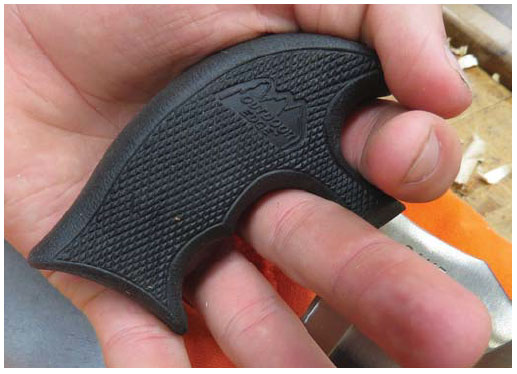
One thing not so intuitive is you will typically put the knife on your non-dominant hand. This is typically going to be your more forward hand in a fighting stance and will save your dominant hand for grabbing your opponent’s body or interacting with your environment.
Most people naturally want to wield the knife in their dominant hand, but that’s less than optimal if you ever have to use it in a true self-defense situation.
Your non-dominant hand isn’t going to be as strong or dexterous as your dominant one, but you’re not writing a letter or opening a jar…you’re throwing a punch. And while an off-hand jab isn’t the most powerful blow, when you have a knife extending over your knuckles, it doesn’t need to be.
Pros and Cons of the Push Dagger
These days, push daggers are still used as a very concealable self-defense tool. They’re fairly intuitive because most everyone has a basic idea of how to throw a punch. Those with any martial arts experience are likely to find them comfortable and familiar to use instinctively.
The predominant variety these days is the New Orleans-style version with the T-shaped handle, but some others do exist. Whichever variety you go with, know you aren’t going to be doing a whole lot of slashing.
These are tools meant for piercing and stabbing, so some traditional knife fighting techniques aren’t going to translate here. Experienced Kali/Escrima practitioners will likely not have any problems at the end of the day, but the knife just isn’t optimized for cutting blows.
Legality of the Push Dagger: Perhaps the Biggest Con

First, let me say none of this is legal advice. I’m not a lawyer, I’m just some guy on the internet who likes knives. Everything here is just what I’ve come to understand from my own research and is subject to be wrong.
Do your research about where you live and plan to own or carry a push knife and ask a licensed attorney.
Bans and Restrictions on Push Daggers
Now, while push knives aren’t outright banned in most states, several do have restrictions on “daggers” and knives designed to cause harm to another person without an obvious other purpose like a hunting knife.
Most push knives have a blade length of less than 3 inches, and many are single-edged so they don’t meet the “dagger” definition in states where this is part of the definition of a dagger. Also, many states have laws about carrying a knife with “intent to harm,” but that applies to any knife.
The things to look out for are the differences in what your state allows you to own versus what you can carry. If you just want to own a push knife as a collector piece, you’re going to have a much easier time than if you want to carry one.
That said, many states have weapons carry licenses/concealed carry permits that not only allow you to carry a firearm, but also a knife, such as a push dagger.
In general, all we can say is to check your state and local laws and make sure you’re not going to violate them by owning or carrying a push knife. Few states flat out say they’re illegal to own, but many have limits on carrying them, especially concealed.
When to Take Special Care
I would advise special caution to anyone living in the following states: California, Connecticut, Hawaii, Iowa, Kentucky, Maine, Maryland, Massachusetts, Michigan, Mississippi, Montana, Nevada, New Jersey, New York, North Dakota, Oklahoma, Pennsylvania, Rhode Island, Virginia, Washington, and West Virginia.
All of these states have some restrictions on what knives you can carry, some have restrictions on ownership in general, and many mention “daggers” without really defining what they consider a dagger.
As always, do your research and cover your backside. Don’t rely on anyone else to do it for you. Other states may have laws I don’t know about or didn’t find information on, and your local city government may have ordinances as well.
Best Push Daggers on the Market Today
Today, we have a huge number of great push daggers on the market, which is both a good and bad thing. On the one hand, we have more choices than ever, which means there’s something out there to fit every need
On the other hand…we have more choices than ever, which can make it hard to choose.
Let’s take a look at the best options on the market today, and narrow the field a bit while also highlighting the best of the best in the world of push knives.
Overview
Condor Tool & Knife Tactical P.A.S.S.
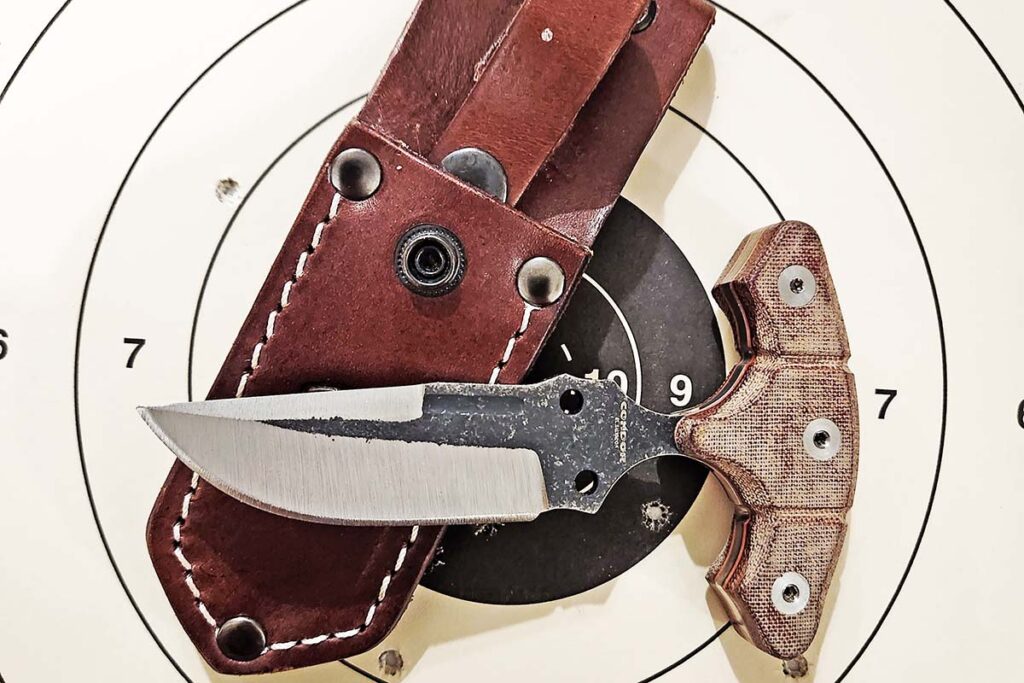
Right off the bat I must say I like the blade of the Tactical P.A.S.S. from Condor Tool & Knife because it departs from the traditional symmetrical dagger design. It pays often enough to try something different, and here it works. The hammer-finished look along with the clip point and false grind give it a rustic appearance. Condor also offers a fixed blade called the Tactical P.A.S.S. with the exact same blade pattern.
Now to talk about a practical bonus of the design. In some states double-edged blades are illegal. Condor’s false edge would allow you to carry the push dagger in such states and stay on the safe side of the law.
The handle size seems just right for my large, meaty hand. In most knives I look for that contoured fit. Due to the fact I want any resistance encountered by this blade absorbed by my palm and wrist, I want the handle to have a broad radius. The P.A.S.S. is in that Goldilocks position.
If I had to give any negative feedback, and I do when I find something wrong, it would be the leather sheath. Oddly enough, it is constructed very well. There are minor issues with the fit and finish but overall it is a sturdy, good-looking build.
My issue is with the design. Condor includes a full belt loop but I find that gets in the way when trying to make a smooth, full, fast purchase. For knives used for self-defense that is what you want—a solid grip and you want it fast. A horizontal and vertical carry patch is on the sheath’s back but will accommodate MOLLE-sized straps only. I know it might seem picky but keep in mind this is a push dagger, and the same rules apply for it as a pistol draw. I think the set-up would be taken to another level if the carrying system was mounted to the back of the sheath only and was large enough to accommodate regular-size belts. Such a change would leave the handle free and open to a quick, secure grasp.
Does the sheath make the knife a bad value? No, most people are either satisfied with the sheath or they aren’t. As a result, your decision to buy a P.A.S.S. might factor in an aftermarket sheath. The knife is still spot on.
Heretic Knives Sleight
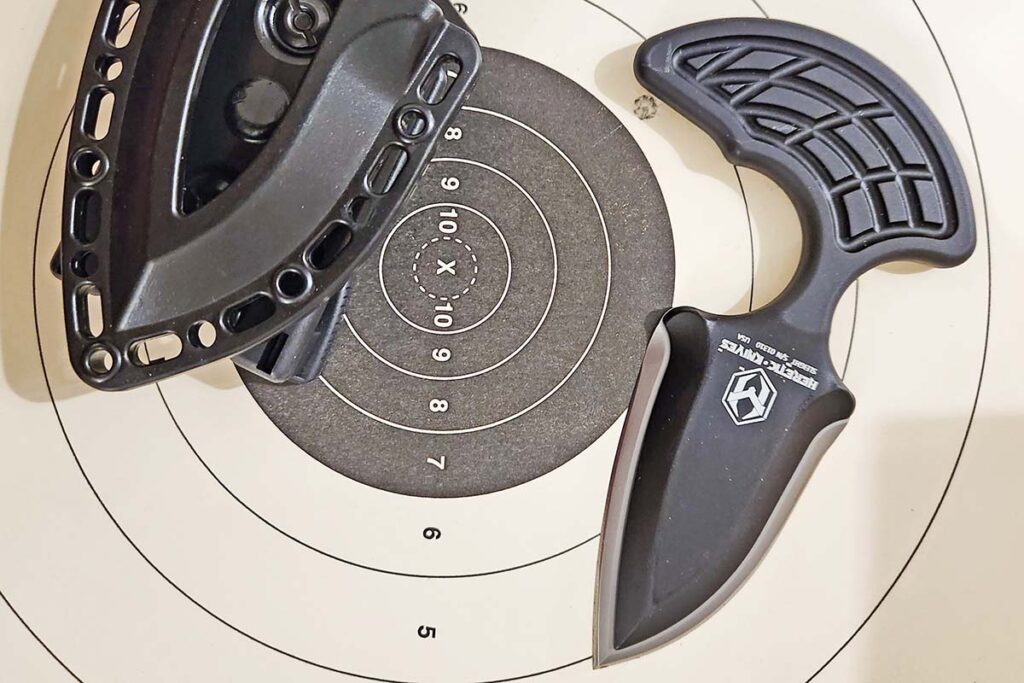
The Sleight from Heretic Knives is a sleek little design. Of the test group it’s the most compact and concealable. The blade is part of an aluminum body with a thin CPM 20CV layer mechanically fastened with screws to it to produce an edge. Such a design gives you the cutting power of a heavier metal while reducing weight. The aluminum body has an asymmetrical, CNC-textured handle. Heretic uses more of a pistol-grip design, enabling you to palm it quickly and have accurate control over the tip.
The Sleight is a great-looking piece of kit. Heretic even gets creative with the sheath, carrying through on the theme of decorative but lightweight. It has a Blade-Tech belt clip on the back for vertical carry.
The small design makes it easier to use for certain cutting chores without drawing too much attention. On the other hand, smaller knives lack the effectiveness of larger ones in self-defense situations.
One thing that bothered me is how difficult it is to draw the knife from the sheath. The first time I did it I thought I was going to have to follow up with a visit to my chiropractor. (OK, an exaggeration, but I must have at least one overstatement per story.) It was and still is difficult to draw and definitely not on the smooth side. Moreover, if you’re trying to pull it out of the sheath in a stealthy manner there is a loud click upon drawing. Perhaps over time it will break in as I sit fidgeting with it while watch Kung Fu reruns.
The Sleight is well made and well designed. It will make a good EDC blade once the sheath is broken in.
TOPS Knives I Stick
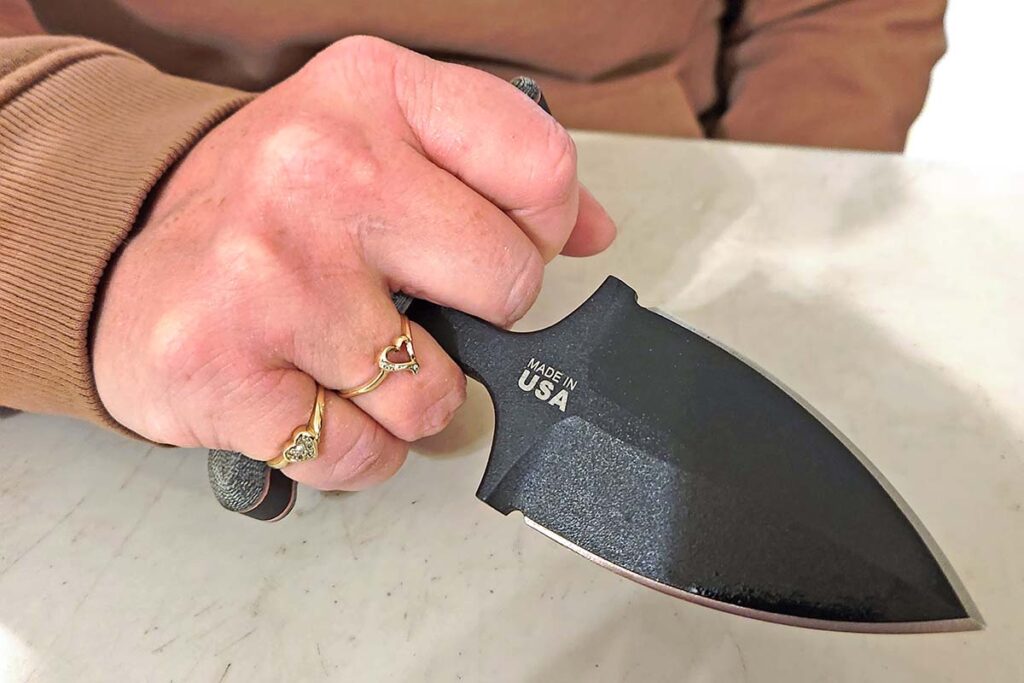
Of the test push daggers, the I Stick by TOPS Knives has to be the largest. According to TOPS, the I Stick weighs 12.6 ounces. When using a knife such as this, size can count—especially in the blade length. At this weight, though, you’d better be prepared for a long day. On its own the weight might not be that much, but when you start adding on your other everyday carry gear it gets burdensome. I am not normally one to point out the weight of a knife, but when they get this heavy you start to notice.
The blade is .38 inch at the thickest. You won’t have to worry about this knife breaking. Scales are black and green Micarta®. I do find the handle a bit big for my hand. The size does allow for a quick, solid grip, though. TOPS structures the handle to be asymmetrical so you can get a full thumb wrap around it. Being able to completely close your fist around the handle makes a world of difference in grip strength. The molded Kydex sheath has belt loops for vertical carry. Before carrying the I Stick, I recommend you practice drawing it from the sheath, as the sheath needs breaking in.
Overall, it is a good knife and has a respectable edge out of the box. Seeing as how it’s on the large side, the decision to purchase it would be something you would need to think over. A knife of this nature is no good if you don’t have program compliance and carry it. If you are not used to carrying a lot of weight, before buying it try carrying around something of comparable size and weight. As far as value, the I Stick is built like a tank. I am sure it will outlast us all and be handed down to future generations.
TOPS Knives Grim Ripper
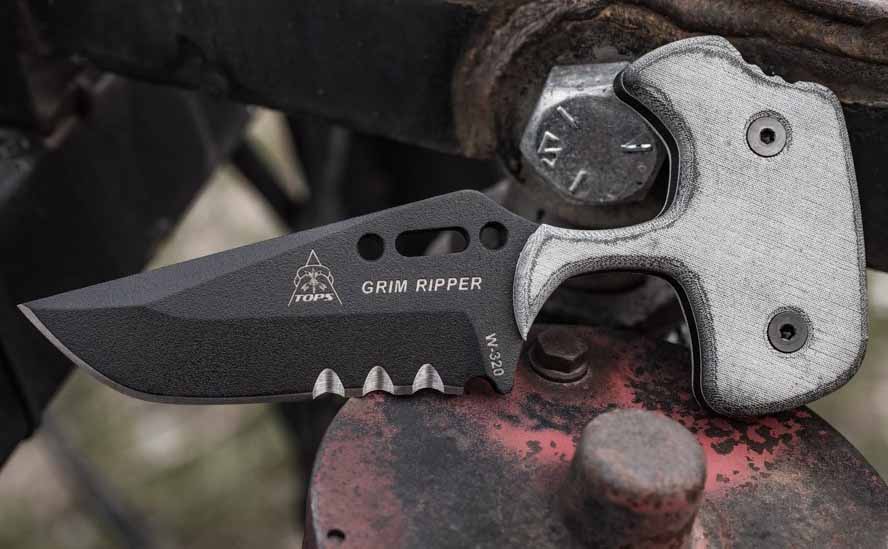
If you want a slightly more utility-focused knife, the TOPS Knives Grim Ripper might be up your alley. It features a shorter two-finger grip that is shaped to lock into your hand. It feels just as secure when wielding, but is less likely to dig into your side or what have you when carrying it.
It features a single-edge blade designed with some wavy semi-serrations ahead of the sharpening choil designed to quickly slice through webbing or ropes in the event of an emergency.
The handle is a very nice gray micarta that won’t get slick if held with wet hands. I felt very secure wielding the Grim Ripper in a variety of light camp tasks and it was easy to slice boxes as well, thanks to the well-designed handle.
The blade is a 3.75-inch long tanto-shaped affair made out of 1095 high-carbon steel for great edge retention and sharpness.
Esee Izula Tertiary
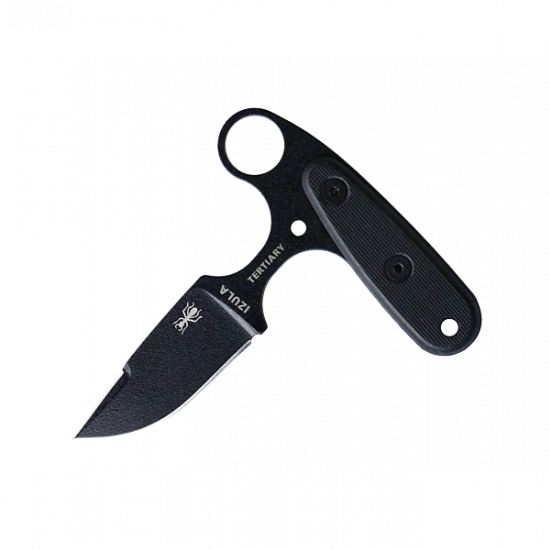
The Esee Izula is a wildly-popular small fixed blade that’s good for everything from opening a reluctant Amazon box to whittling by the fire. But the Tertiary version is geared strongly towards defense with its T-shaped handle and perpendicular blade.
“Izula” is the local Peruvian word for the bullet ant, one of the fiercest insects on the planet and the one with the most painful sting. I’d say Esee named its knife appropriately.
It is very compact and concealable, but easy to draw quickly when you need it. The grip allows for you to easily hold the stem between your first and second or second and third fingers, depending on your preferences, and is comfortable and secure in the hand.
The 2.625-inch blade is made out of 1095 steel and features a clip point so it is more acceptable in those places that might take issue with someone concealing a double-edged blade.
Cold Steel Safemaker II
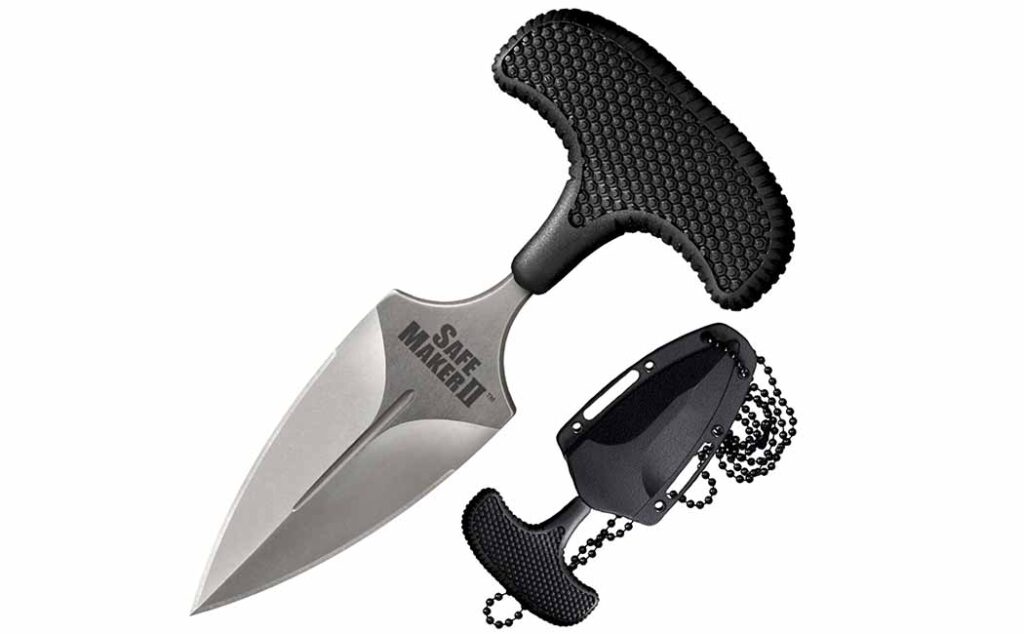
The Cold Steel Safemaker is, in my opinion, one of the knives that’s most true to the origins of the push dagger or push knife. It’s cheap, easy to conceal, and it’ll put a hole in an attacker. For those looking for an affordable and discrete means of protection, it’s difficult to argue against it.
Is the AUS-A8 steel the best? No. Does it have the best handle? No. Does it do what you need it to and will it hold up well in a self-defense situation? Absolutely.
Remember, this isn’t meant to be your EDC knife you blunt the edge on by opening boxes and slicing through tape all day…its meant for self-defense. To that end, if you do ever use it, it probably only really needs to be sharp once.
I’m all about lowering the barrier of entry to self-defense. I think too much emphasis is sometimes put on high-speed, low-drag designs made with the highest-quality materials out there and sometimes that distracts from the fact you don’t need any of those features most of the time.
I say that as someone who carries a $400 knife as my main EDC. I get it. But I also recognize the fact knives can be expensive for folks who have other priorities and other things they need to spend money on. That shouldn’t keep them from being able to defend themselves though.
The last I’ll say about it is a little anecdote that has stuck with me.
I had a friend tell me a story about a fellow Marine who chuckled during a briefing at the idea of facing a likely enemy armed with decades-old AKs. The unfortunate Marine’s Sergeant then sharply reminded him “Cain got the job done with a rock.”
That’s something I like to keep in mind when talking about weapons. Sometimes, you don’t need the best materials. Sometimes, you just need something to get the job done. And the Safemaker and the smaller Safemaker II will get the job done.
The Safemaker II has a 3.5-inch blade made out of very budget-friendly AUS-A8 steel.
CRKT Tecpatl
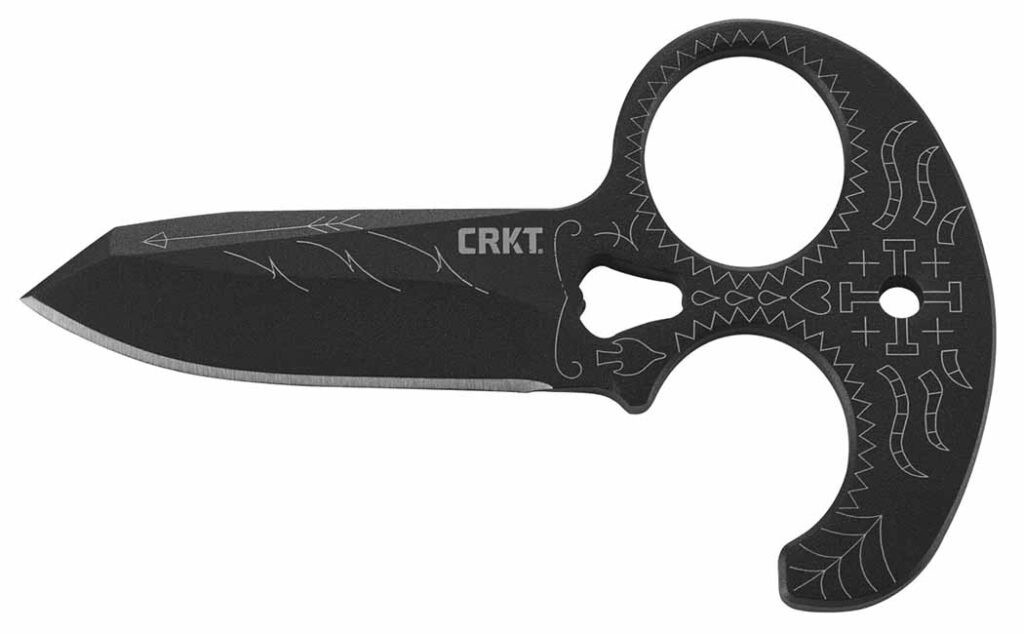
The Tecpatl by CRKT is a modern take on the push dagger designed by Army Special Forces veteran Michael R. Rodrigues as part of CRKT’s high-end Forged By War line of knives designed by or in collaboration with combat veterans.
Mr. Rodrigues is a bladesmith himself, and brought years of front-line experience to his version of the push dagger. It features an upswept Warncliffe profile making it fairly effective at utility tasks in a pinch, but it’s clear this is a knife meant to do damage to an attacker.
The handle is ergonomically shaped to give you a few different grip options depending on your preferences and what you’re doing with the knife, and I found it to be very comfortable and secure no matter what I was doing with it.
The 3.375-inch hollow-ground blade is made of Japanese SK5 carbon steel.
GTI Push Knife
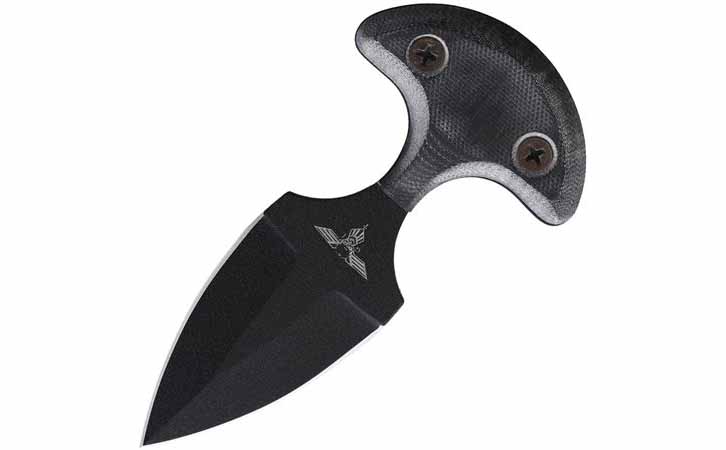
Gingrich Tactical Innovations has (somewhat predictably, if you know anything about Justin Gingrich and his style) turned their attention to the push knife. Equally predictably they’ve given us something excellent.
GTI’s take on the push knife features a full tang design incorporating a generous handle to give you a secure grip in difficult conditions, like say, when you’re desperately defending yourself. Always nice to see the practicalities of being in a knife fight take precedence in a defensive knife design.
It also comes with a nice Kydex sheath that, on the one I handled, was one of the better examples of a push knife sheathe I’d seen. It covers everything but the oversized handle to protect the steel from moisture, but still allows the knife to slip free easily when you need it.
That big chunky handle is covered in excellent non-slip Micarta scales and tapers down to a sensible 2.6-inch blade made out of D2 steel.
WE Knives Typhoeus
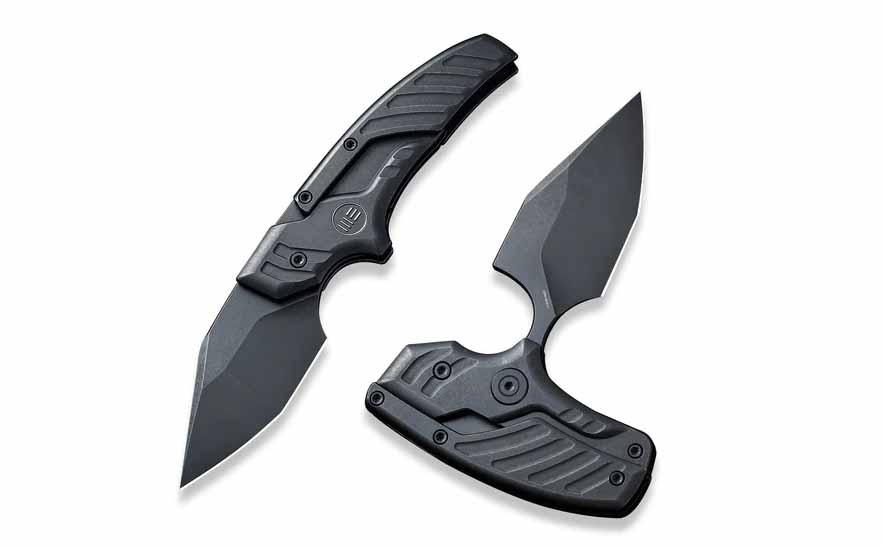
Lastly, we have the most unique knife on this list. The WE Knives Typhoeus, which is essentially a push knife that transforms into a more standard fixed-blade knife. But it’s not a fixed blade and it’s not a folder either… it’s confusing, I have to admit.
Even WE Knives seems unsure how to classify the Typhoeus because of the way it works. At its default, holstered state, it’s a fairly standard push knife, with an asymmetrical T-shaped handle that is very comfortable to grip.
But you can then push the knife blade up and have it snap forward parallel to the handle, giving you a more traditionally shaped knife you can use for everyday knife tasks.
It is available in three different finishes and uses an excellent CPM-20CV steel in the 2.27-inch blade.
Editor’s Note: Matt Collins and Abe Elias contributed to this article.
Check Out More Buyer’s Guides:
Read the full article here




